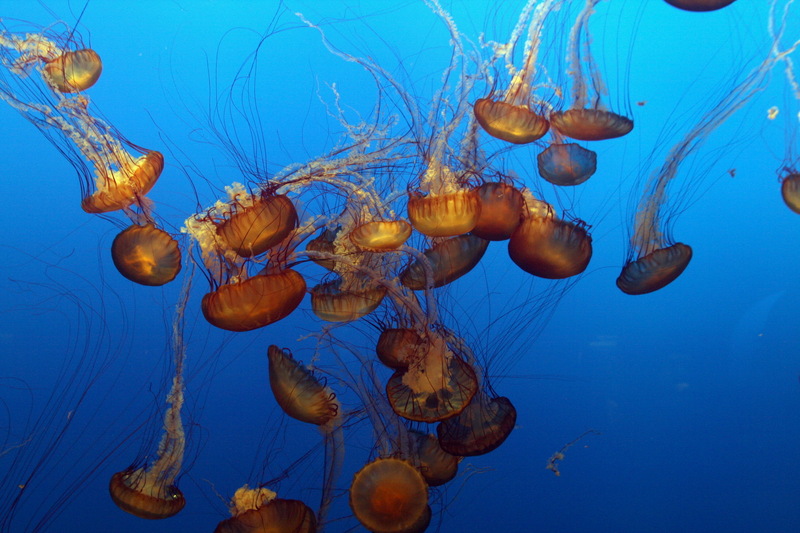Sea Nettle Jellyfish (Chrysaora quinquecirrha) - Wiki Sea nettle
From Wikipedia, the free encyclopedia
[Photo] Sea Nettle Jellyfish (Chrysaora quinquecirrha) in captivity in the Monterey Bay Aquarium. Date September, 2006. Author Mila Zinkova (http://home.comcast.net/~milazinkova/Fogshadow.html)
Copyright (C) 2006 Mila Zinkova
Permission is granted to copy, distribute and/or modify this document under the terms of the GNU Free Documentation License, Version 1.2 or any later version published by the Free Software Foundation; with no Invariant Sections, no Front-Cover Texts, and no Back-Cover Texts. A copy of the license is included in the section entitled "GNU Free Documentation License". |
The stinging
sea nettle (
Chrysaora quinquecirrha) is a species of
jellyfish occurring particularly in Atlantic estuaries. It is a bell-shaped invertebrate, usually semi-transparent and with small, white dots and reddish-brown stripes;
Sea nettles without stripes have a bell that appears white or opaque. The nettle's sting is rated from "moderate" to "severe" and can be pernicious to smaller prey; it is not, however, potent enough to cause human death, except by allergic reaction. While the sting is not particularly harmful, it can cause moderate discomfort to any individual stung. The sting can be effectively neutralized by misting vinegar over the affected area. This keeps unfired nematocysts from firing and adding to the discomfort.
The
sea nettle is radially symmetrical, marine, and carnivorous. Its mouth is located at the center of one end of the body, which opens to a gastrovascular cavity that is used for digestion. It has tentacles that surround the mouth to capture food. Nettles have no excretory or respiratory organs. Each
sea nettle is free-swimming and can reproduce both sexually and asexually.
Feeding habits
Stinging
sea nettles are carnivorous. They generally feed on zooplankton,
ctenophores, other jellies, and sometimes
crustaceans. Nettles immobilize and obtain their prey using their stinging tentacles. After that, the prey is transported to the gastrovascular cavity where it is subsequently digested.
Nettles also eat young
minnows,
bay anchovy eggs, worms, and
mosquito larvae.
Defense mechanisms
Each nettle tentacle is coated with thousands of microscopic nematocysts; in turn, every individual nematocyst has a "trigger" (cnidocil) paired with a capsule containing a coiled stinging filament. Upon contact, the cnidocil will immediately initiate a process which ejects the venom-coated filament from its capsule and into the target. This will inject toxins capable of killing smaller prey or stunning perceived predators. On humans, this will most likely cause a nonlethal, but nevertheless painful rash typically persisting for about 20 minutes. Some earlier cases of nettle stings from the Philippines reportedly had more severe effects: one account describes a sting causing vascular insufficiency, and another mononeuritis.
Rather than toxic substances, some nematocysts contain adhesion used to entangle or anchor its target.
http://en.wikipedia.org/wiki/Sea_nettle| The text in this page is based on the copyrighted Wikipedia article shown in above URL. It is used under the GNU Free Documentation License. You may redistribute it, verbatim or modified, providing that you comply with the terms of the GFDL. |
